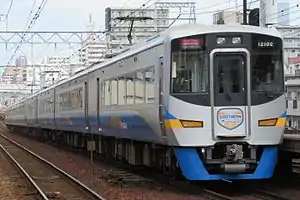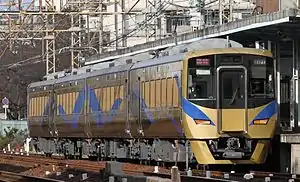| Nankai 12000 series | |
|---|---|
 A 12000 series set on a Southern service in August 2015 | |
| In service | 1 September 2011 – present |
| Manufacturer | Tokyu Car Corporation |
| Built at | Yokohama |
| Replaced | Nankai 10000 series |
| Constructed | 2011 |
| Number built | 8 vehicles (2 sets) |
| Number in service | 8 vehicles (2 sets) |
| Formation | 4 cars per trainset |
| Fleet numbers | 12001–12002 |
| Capacity | 242 |
| Operators | Nankai Electric Railway |
| Depots | Suminoe |
| Lines served | Nankai Main Line, Nankai Wakayamakō Line, Nankai Kōya Line, Semboku Rapid Railway |
| Specifications | |
| Car body construction | Stainless steel |
| Car length |
|
| Width | 2.82 m (9 ft 3 in) |
| Height | 4.14 m (13 ft 7 in) |
| Floor height | 1,150 mm (3 ft 9 in) |
| Maximum speed | 120 km/h (75 mph) |
| Traction system | MB-5091-A2 (180 kW) x4 per motor car (Variable-frequency) |
| Power output | 1,440 kW per 4-car set |
| Acceleration | 2.5 km/h/s |
| Deceleration | 3.7 km/h/s (service) 4.0 km/h/s (emergency) |
| Electric system(s) | 1,500 V DC |
| Current collector(s) | Overhead wire |
| Bogies | SS177M (motored) SS177T (trailer) |
| Multiple working | Nankai 8000 series, Nankai 8300 series, Nankai 9000 series |
| Track gauge | 1,067 mm (3 ft 6 in) |
The Nankai 12000 series (南海12000系, Nankai 12000-kei) is an electric multiple unit (EMU) train type operated by the private railway operator Nankai Electric Railway in Japan on Southern Premium limited express services between Namba and Wakayamashi since September 2011.[1][2] Two four-car trainsets were delivered, replacing the older 10000 series sets.[3]
Design
The new trains feature "Plasmacluster" air-purification technology developed by Sharp Corporation, representing the first use in a private operator (i.e. non-JR) train in Japan.[4]
Passenger seats are 460 mm (18 in) wide, 25 mm (0.98 in) wider than in previous trains, and AC power outlets are provided.[4]
Operations
- Southern
- Semboku Liner (sometimes substituted for 11000 series)[5]
 A 12000 series coupled with a 9000 series set on a Southern service in September 2016
A 12000 series coupled with a 9000 series set on a Southern service in September 2016
Formation
As of 1 April 2016, the fleet consists of two four-car sets, formed as follows, with two motored ("M") cars and two non-powered intermediate trailer ("T") cars, and car 1 at the Wakayamashi end.[2][6]
| Car No. | 1 | 2 | 3 | 4 |
|---|---|---|---|---|
| Designation | Mc2 | T2 | T1 | Mc1 |
| Numbering | MoHa 1210x | SaHa 1285x | SaHa 1280x | MoHa 1200x |
| Weight (t) | 40.5 | 32.0 | 30.5 | 41.5 |
| Seating capacity | 50 | 64 | 68 | 60 |
The two end cars are each fitted with one PT7144-B single-arm pantograph.[2]
Interior
Car 1 has a universal access toilet.[6]
 The train interior in April 2012
The train interior in April 2012
History
Two four-car sets were delivered from the Tokyu Car Corporation (now Japan Transport Engineering Company) factory in Yokohama in February 2011.[7] The trains entered service on 1 September 2011.[6]
See also

- Semboku 12000 series, a derivative operated by the Semboku Rapid Railway on Semboku Liner services since January 2017
References
- ↑ 私鉄車両年鑑2013 [Japan Private Railways Annual 2013] (in Japanese). Tokyo, Japan: Ikaros Publications Ltd. 20 March 2013. p. 125. ISBN 978-4-86320-693-9.
- 1 2 3 南海電気鉄道 12000系(特急車両) [Nankai Electric Railway 12000 series Limited Express EMU]. Tetsudō Daiya Jōhō Magazine. Vol. 40, no. 328. Japan: Kotsu Shimbun. August 2011. pp. 78–79.
- ↑ 南海電気鉄道 12000系(特急車両) [Nankai 12000 series limited express EMU]. Tetsudō Daiya Jōhō Magazine. Vol. 40, no. 327. Japan: Kotsu Shimbun. July 2011. p. 69.
- 1 2 南海電鉄:特急「サザン」に新型車両 今秋にも運転 [Nankai to introduce new trains on "Southern" limited express services from this autumn]. Mainichi jp (in Japanese). Japan: The Mainichi Newspapers. 17 January 2011. Archived from the original on 18 January 2011. Retrieved 28 October 2016.
- ↑ 特急列車のご案内 [Guidance of Limited express train] (in Japanese). Japan: Nankai Electric Railway. Retrieved 14 November 2015.
- 1 2 3 私鉄車両編成表 2016 [Private Railway Rolling Stock Formations - 2016] (in Japanese). Japan: Kotsu Shimbunsha. 25 July 2016. p. 148. ISBN 978-4-330-70116-5.
- ↑ 南海12000系が甲種輸送される [Nankai 12000 series delivered]. Japan Railfan Magazine Online (in Japanese). Japan: Koyusha Co., Ltd. 8 February 2011. Archived from the original on 4 March 2016. Retrieved 9 March 2011.
External links
- Nankai Electric Railway 12000 series Southern Premium (in Japanese)